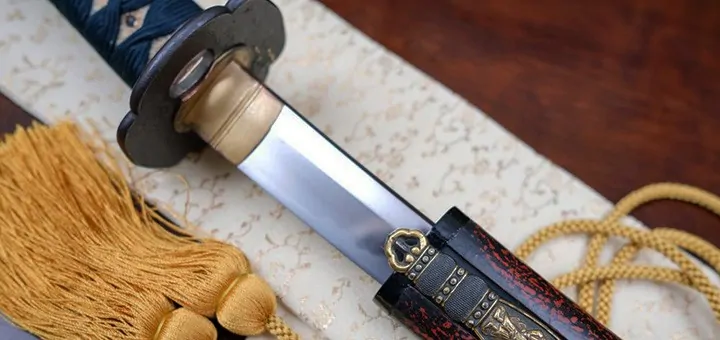
There are so many different types of Japanese swords out there it’s completely impossible to keep track of them.
I am certain you already know the basic ones such as katana, tachi or tanto, but you probably never heard of uchigatana or zanbato right?
For this reason, I wrote this article dedicated to the different types of Japanese swords, so that you can keep track of all the various kinds of Japanese swords.
Furthermore, I translated all the Japanese sword names and added their meanings.
Table of Contents
Katana (sword)
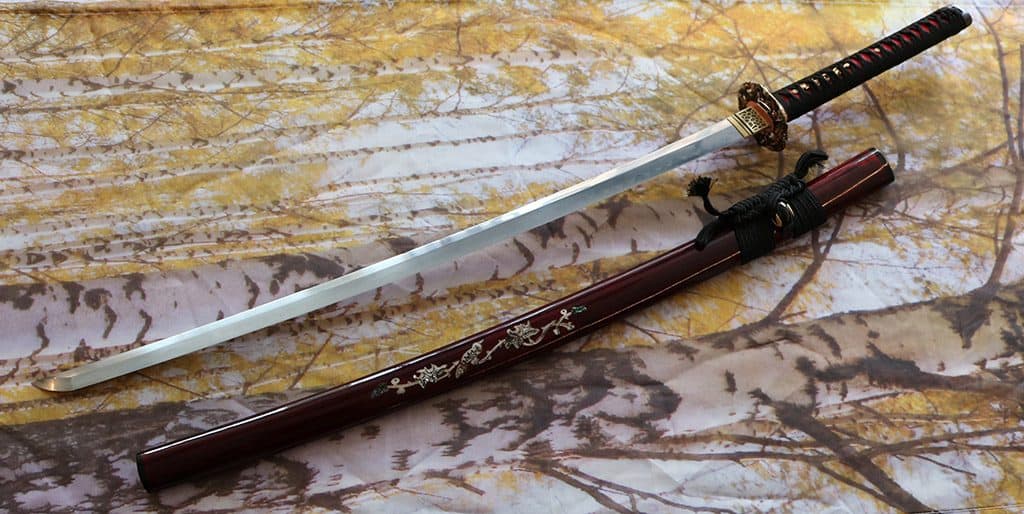
Let’s go guys. We’re getting right at it with probably the most famous of Japanese swords, the katana. I am quite certain that most people know katanas, because of their prominent appearance in modern pop culture.
The katana is the sword that oftentimes gets referred to as “Samurai Sword”. The term “Katana” means “sword“ in English.
After all the katana was part of the equipment of every samurai in ancient and feudal Japan. This sword is characterized by a slightly curved, single-edged blade.
In contrast to the European arming sword, the grip of the katana is long enough to accommodate two hands. The hands of the warrior were protected by either a circular or squared guard.
The katana is vaunted for its superior cutting ability and sharpness. In contrast to medieval swords, the katana is able to chop off entire limbs.
The total length of a katana is around 100 to 110 cm (39.4 to 43.3 in) and weighs 900 to 1400 grams (2 lbs to 3.1 lbs).
Tachi (big sword)
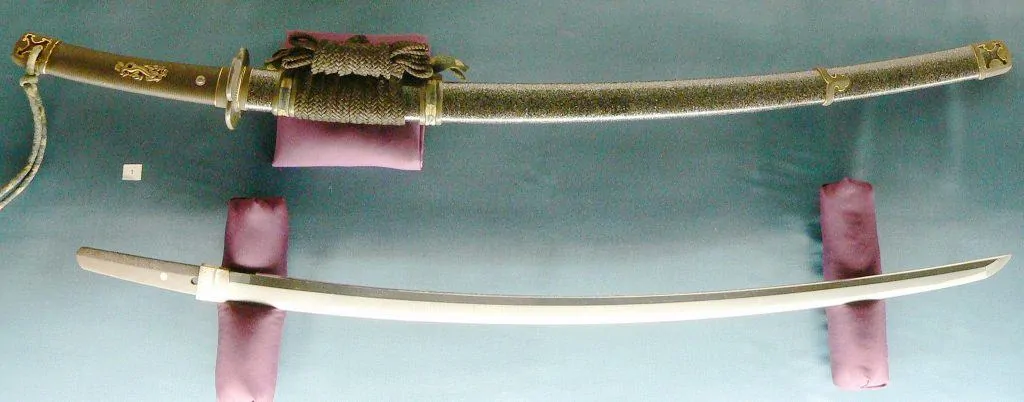
The tachi is the next type of Japanese sword I am going to cover.
It features a curvier and slightly longer blade than the katana. For this reason, tachi translates to “big sword”.
The additional curvature improves the ability to cut while drawing the blade, which is called nukitsuke. This art was also performed on a regular katana, however due to its slight curvature it didn’t give the wielder much of an advantage.
By utilizing the Japanese tachi this technique comes to greater use. Furthermore, the tachi was commonly used on horseback to strike down infantry units.
The length of a tachi ranges from 120-130 cm (47.2-51.2 in). Moreover, it is important to note that it was worn with the cutting edge facing downwards.
Odachi (large sword) / Nodachi (field sword)
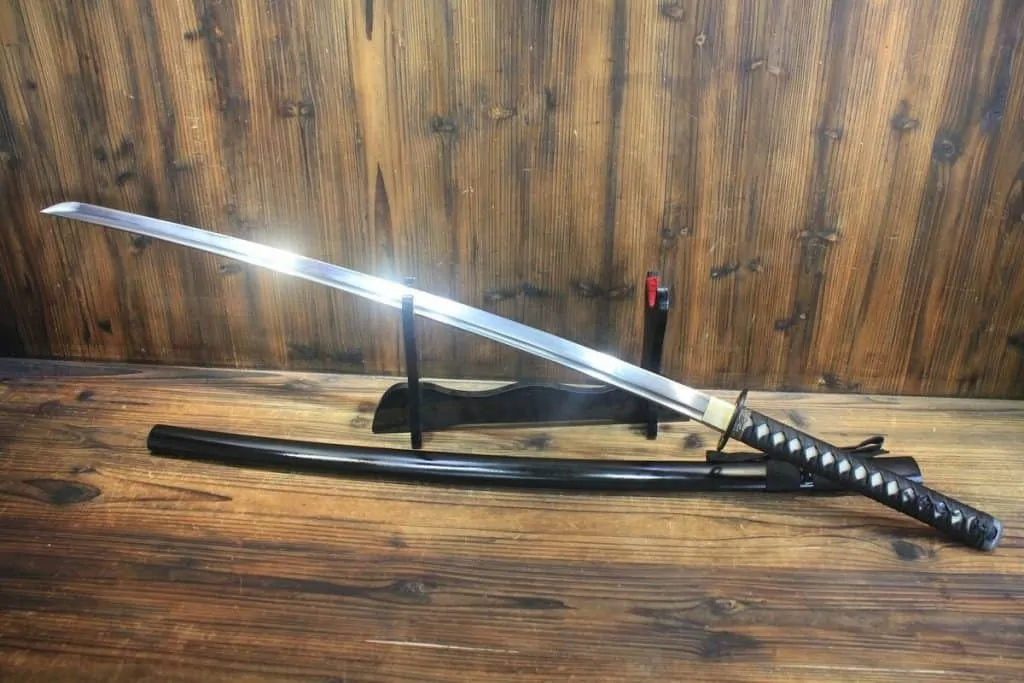
Oh, we’re getting to the big weapons guys. This kind of Japanese sword is extremely fancy for sure.
Odachi and Nodachi are referring to the same sword, so I am using them as synonyms. Now let’s get to the specifications of the nodachi.
Those are huge swords. Just their sight sparked fear among enemy lines. Resulting from their massive size of over 150 cm (59 inches). (I mean I wouldn’t like to fight such an enemy)
This makes the nodachi the longest type of Japanese sword.
For this reason, the nodachi sword was the perfect counter against mounted units. You could say it was an overpowered weapon against cavalry.
But even the greatest weapon comes with disadvantages. Its massive size renders it completely useless inside buildings or for close-quarter fights.
The nodachi was commonly used in the late 14th century. As a result of its massive size the nodachi needed to be worn on the back of the samurai.
In case you require additional information about the nodachi check out my complete guide.
Tanto (short sword)

Now let’s jump from the biggest Japanese sword to the smallest one. The tanto is more of a dagger than a real sword.
The primary purpose of the tanto was stabbing your opponent. The length of the blade ranges from 15 to 30 cm (5.9 to 11.8 in). The average total length of a tanto is around 40 cm (15.8 in).
In contrast to most other Japanese blades, the tanto has a completely straight blade. Furthermore, the tanto can either be single or double-edged.
Wakizashi (side inserted sword)
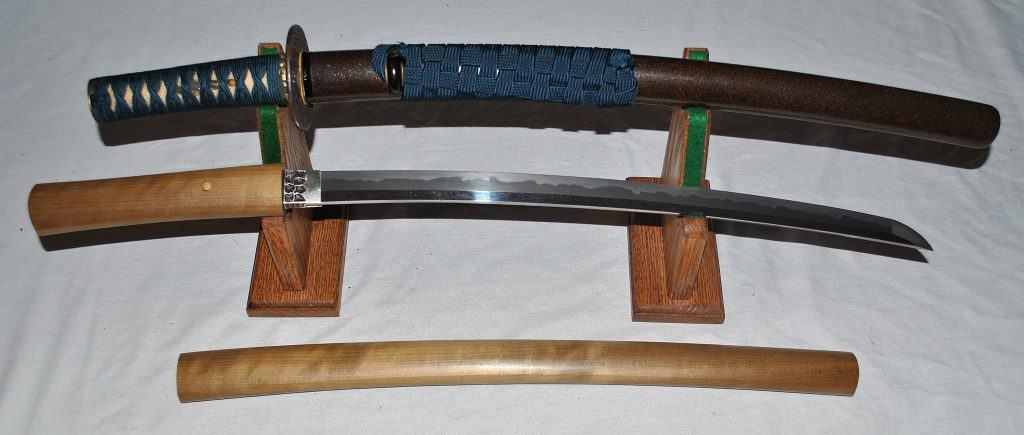
The term wakizashi means side inserted sword. In comparison to the katana, it is slightly smaller. The average length of a wakizashi ranges from 80 to 90 cm (31.5 to 35.4 inches).
In contrast to the katana, the wakizashi was not only worn by samurai. Instead every class had free access to get this kind of sword.
The wakizashi found its use in the early 17th century. The origin of the name comes from the fact that it was often used as a complement to the katana. Thus the name “side inserted sword”.
The katana was the perfect weapon to pair with the wakizashi. You got both the advantages of a long sword and a short sword. Hence, dual-wielding both swords was possible to achieve the best fighting results.
Oftentimes the wakizashi was referred to as “honor blade” because it was used as a backup weapon to kill defeated enemies or to commit ritual suicides called seppuku.
While it was rude to walk into a building armed with a katana, wearing the wakizashi caused no offense. Samurai were equipped with their wakizashi all the time from waking up in the morning till going to bed.
Some samurai even slept with their sword under their pillow. I mean you must be prepared for everything right?
The famous rōnin Miyamoto Musashi was also using and teaching a double-bladed fighting style. He has fought his duels armed with a katana and a wakizashi as well. However, this fighting style requires a lot of practice and patience.
Uchigatana (sword to strike with)
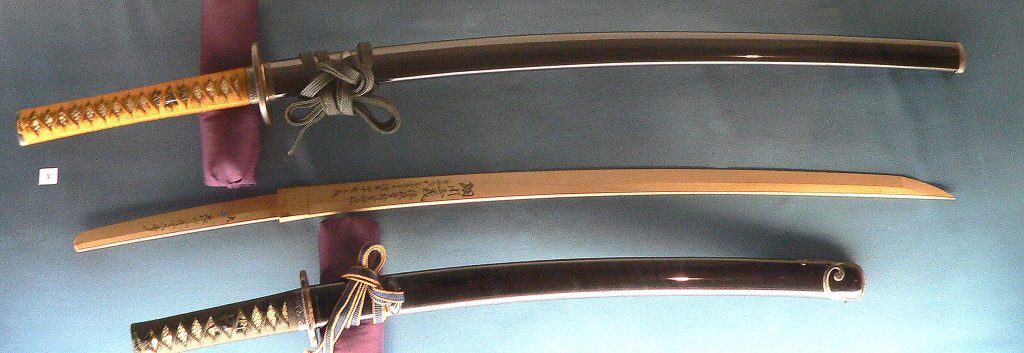
The uchigatana probably one of the unknown types of Japanese swords. The uchigatana was a descendant of the tachi.
This kind of sword was used by the samurai class of feudal Japan. It developed during the 15th century. The length of an uchigatana is similar to that of a katana. So it measured 100-110 cm (39.4-43.3 in).
Its relatively short handle makes it very light and easy to use single-handed.
In contrast to the tachi the uchigatana was worn edge-up in the belt. Unlike with the tachi were drawing and striking were two separate actions the uchigatana made it possible to combine them into one single movement.
Combat in Japan was always happening quickly and having a blade that allows for faster strikes is very advantageous. For this reason, this sword types found wide acception in entire Japan.
Whereas the curvature of the tachi is near the sword’s hilt the curvature of the uchigatana is near the point (kissaki). This change enables cutting while drawing (Nukitsuke) on horseback as well.
Tsurugi
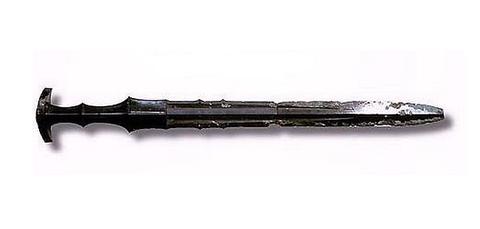
The Japanese tsurugi is a very special kind of sword. The blade is straight and double-edged was used in antiquity.
This sword type is similar to the Chinese jian. There is little information about this sword type available. The long name of this sword is “Kusanagi-no-Tsurugi”. It is considered as one of the three Imperial Regalia of Japan.
Chokuto (straight sword)
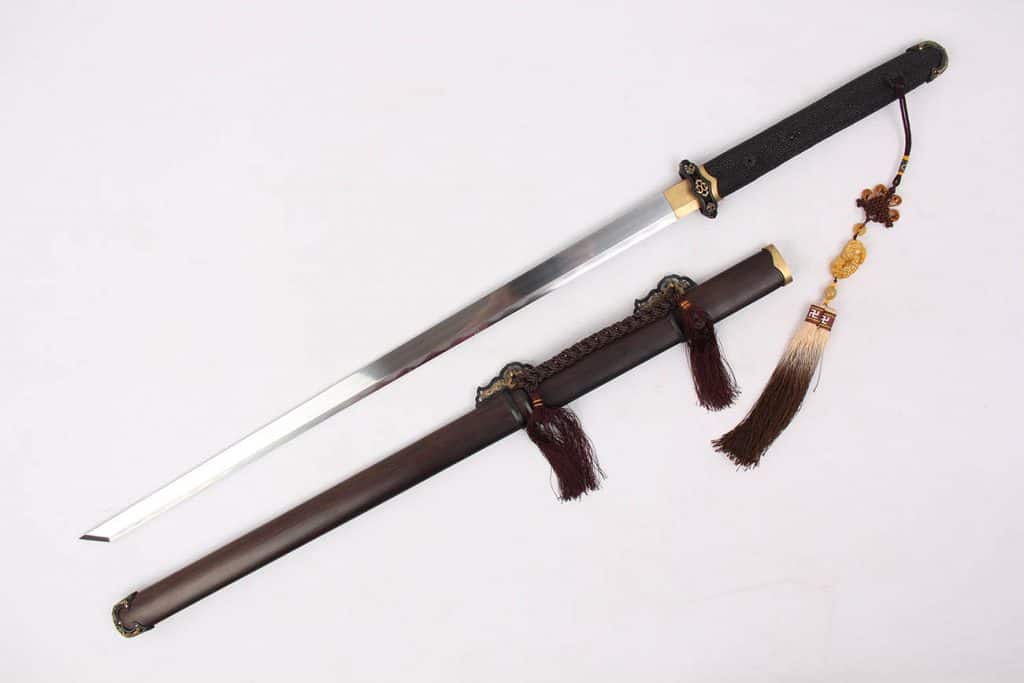
The chokuto is a rather old Japanese sword. Nonetheless, it is very special. In contrast to most other swords, it was neither differentially hardened nor folded.
I think this might be due to usage prior to the 9th century. Since it is one of the earliest Japanese swords in existence the technique of differential tempering and folding wasn’t commonly used.
Due to my lack of history knowledge I wanted to ask this question on Quora however I misspelled my question and wrote “katana” instead of “Japanese sword”. I will probably never know when the first Japanese sword was differentially hardened. ☹
But now let’s follow this up with the specifications of this sword type. The chokuto is a straight single-edged sword. This sword type was worn hung on the waist. Foot-Soldiers used it to slash and stab their enemies.
The chokuto originated in China where it came over to Japan by sea.
Kodachi (short tachi/sword)
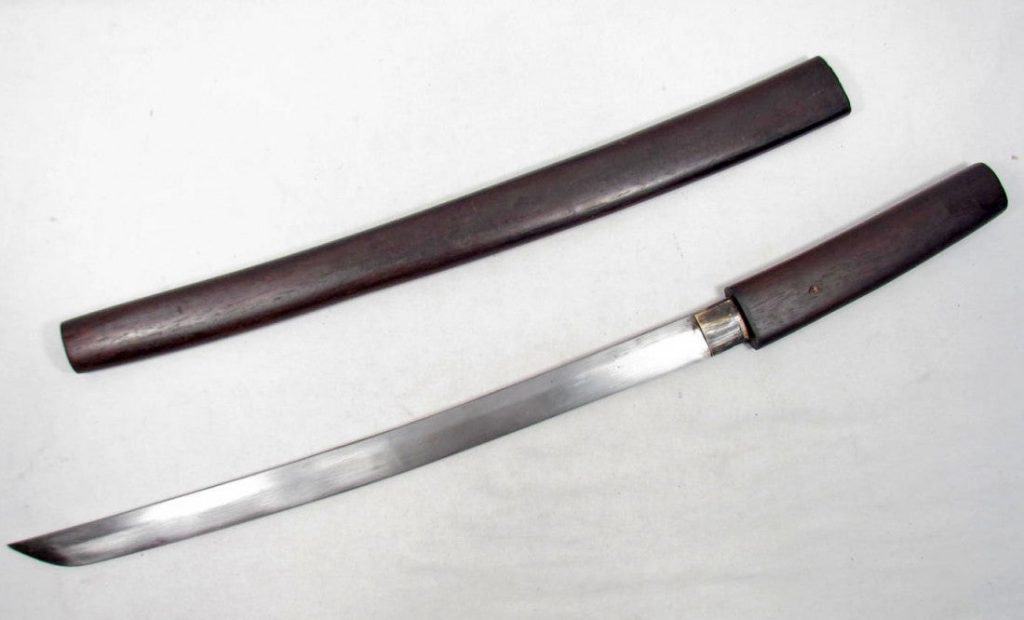
The kodachi is a smaller version of the tachi. The word “ko” translates to “small”. Their appearance is extremely similar to that of a regular tachi.
However, as you might expect, they are smaller. With a total length of around 85 cm (33.5 in) they are around 40 cm (15.8 in) smaller than a tachi sword.
This is very interesting as this sword was developed in the late 12th century. To put it bluntly the Japanese “downgraded” from a big sword to a short sword.
However, after closer inspection, I realized that it was extremely similar to the wakizashi which was developed 500 years later.
At first, I thought that the kodachi might have been used as backup sword as well. However, this sword type was only used as primary armament.
Thus, it was the perfect weapon for the regular citizen. The kodachi was commonly used by travelers, caravans and merchants as a self-defense weapon.
Ninjato
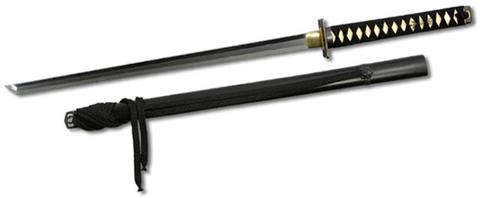
There are a lot of different spellings of this one out there. Ninjato, ninjaken or shinobigatana are all referring to the same sword.
Let’s take a closer look at the name of this blade. Do you know which group was using this blade? I mean obviously, this sword was primarily used by the ninja (shinobi). I hope you didn’t get this one wrong. :D
At least this is what pop-culture makes us believe. The existence of the Ninjato is debated. Whether or not this sword really existed I can not give you any further information, as there isn’t much to be said here.
In terms of appearance, the ninjato features a straight blade. People are claiming that this sword was used by the ninjas during the Edo-period (17th to 19th century). However, this sword type was first seen in the 20th century in a ninja museum.
Nagamaki (long wrapping)

This samurai sword features an extra-long handle. Typically the blade and handle (tsuka) have roughly the same size. Amounting to a total of 2 meters (6.6 ft).
That’s very astounding and frighting. This weapon is the perfect counter against cavalry forces. The blade was single-edged. Like a katana, the nagamaki features a handle made of ray skin.
The sword got its name from the process of wrapping the handle with leather or silk cords. This special handle improved the grip a lot.
This kind of samurai sword evolved in the 14th century. Wielding this type of sword is very specific. You need to place your hands in a fixed position much like with a katana.
Very few sliding actions are performed on the handle while handling the nagamaki sword. This blade is mainly used large sweeping and slicing strokes.
Zanbato (horse-slaying sword)
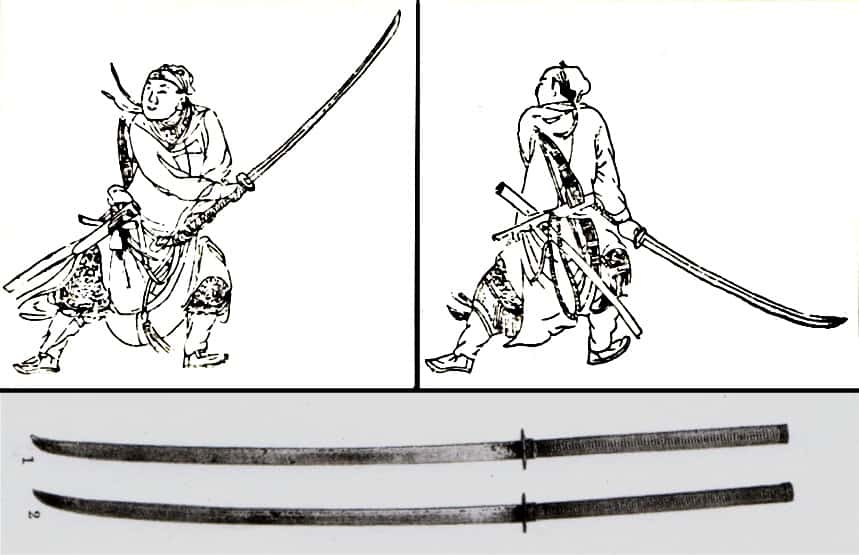
This sword type didn’t receive its name just for fun. The power of this weapon is incredible. This single-edged sword dates back to the Heian period (8th to 12th century).
As you might already have realized this sword type translates to horse-slaying sword. And that’s for a reason.
The zanbato features an extremely large blade. Therefore it is the optimal counter to cavalry units. The sword was created to cut off limbs of horses.
There is this myth going around that a zanbato can chop through a horse and rider in one single stroke. As always I beg you to use your common sense and don’t get influenced by those exaggerated myths.
Of course, the zanbato couldn’t cut through a horse and rider. Obviously it couldn’t “even” cut through one of the enemies completely. Swords weren’t as superior as most people think.
Over the centuries the zanbato was replaced by even deadlier weapons. In the late 14th century the zanbato was replaced by the nodachi for example.
The Japanese were inspired to create this sword by the Chinese equivalent zhanmadao. This Chinese sword was created in the Han dynasty and used until the Song dynasty (206 BC – 1279 AD).
Daisho (big-little)
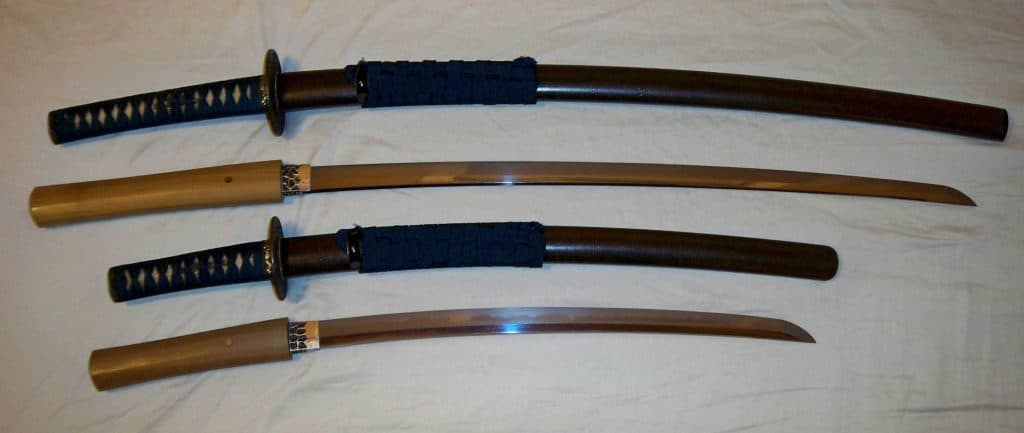
The daisho describes a matched pair of Japanese swords. To fully understand what is meant by the term daisho we have to look at two different terms first.
The term daito literally means “big sword”. Daito isn’t a sword per se, instead it is a class of swords which have a blade length of 2 shaku or more (60+ cm/23.9+ in).
The other word we need to take a look at is shoto. This term translates “short sword”. Shoto refers to swords with a blade length of 1 to 2 shaku (30-60 cm/11.9-23.9 inches).
You already read about lots of swords that are in this category. The wakizashi or kodachi, for example, are both shoto.
Take note that this categorization depends on the blade length and not on the total length of the sword.
But what is daisho exactly? It is a combination of both of these words daito + shoto = daisho.
So daisho isn’t a really a sword but rather a combination of a short and a long sword. This was typically depicted by wielding a katana in combination with a wakizashi.
Another valid approach to this would be pairing a uchigatana and a tanto.
Yoroi-dōshi (armor piercer)
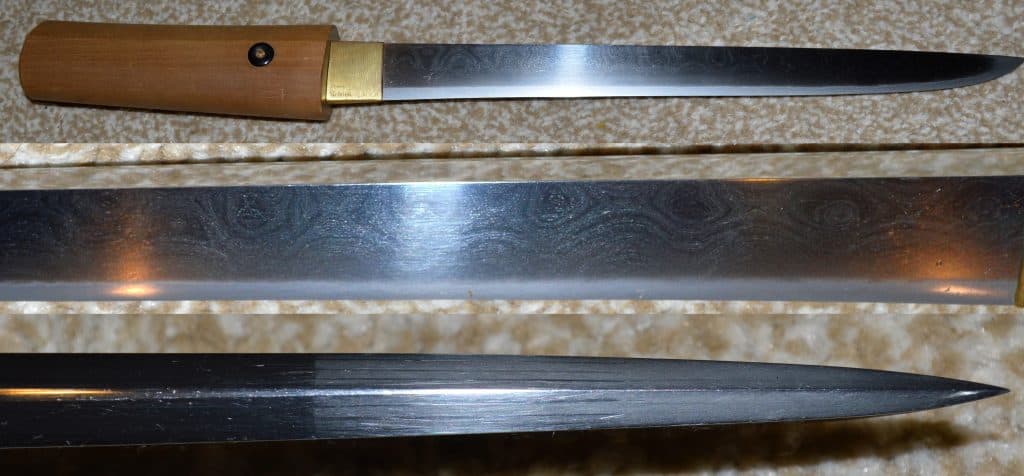
This is one of the traditional Japanese swords that were worn by the samurai class in feudal Japan.
This weapon is just an extra thick tanto knife. It appeared in the Sengoku period of the 14th and 15th centuries. The extra thickness at the spine of the blade is what makes it different from a regular tanto.
The main purpose of the yoroi-doshi was to pierce mail armor. Furthermore, it was perfect for stabbing while grappling in close quarters. The total length of the weapon was around 20-30 cm (7.9-11.8 in).
Yoroi-dōshi were worn inside the belt on the back or on the right side with the hilt toward the front and the edge upward.
For this reason, this sword had to be drawn with the left hand. Thus it earned the name metezashi meaning “horse-hand blade”.
Kaiken
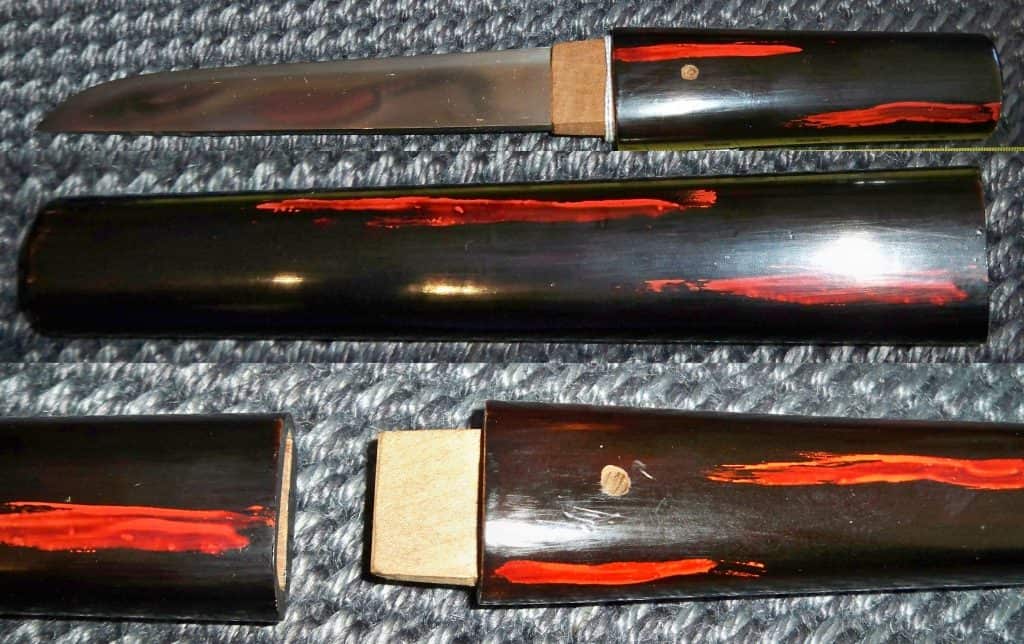
This Japanese dagger features a single or double-edged blade with a length of 20-25 cm (7.9-9.8 in). This dagger type didn’t have ornamental fittings and was housed in a plain mount.
Originally this blade was carried by regular Japanese people. This was the perfect tool for self-defense in indoor-places where a longer blade would be of no use.
When a samurai woman married, she was expected to carry a kaiken with her when she moved in with her husband.
Women carried this dagger in their kimono either in their sleeve pouch or in a pocket-like area.
Besides its use as a weapon for self-defense, the kaiken was also commonly used to perform ritual-suicide called seppuku.
Bokken (wood sword)
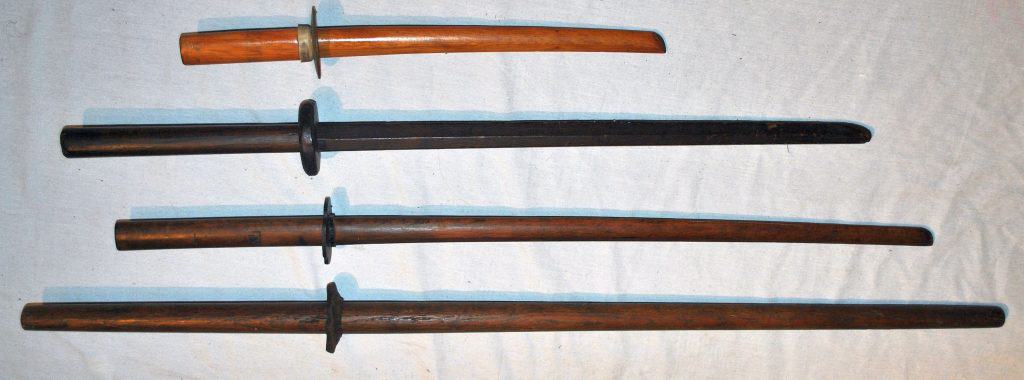
“You can only fight the way you practice” is a quote by Miyamoto Musashi that perfectly describes the bokken.
The wooden sword is commonly used for training. Most commonly the bokken has the shape of a katana.
However, as with all things, there are variations the bokken is available as wakizashi or tantō as well. The bokken was designed to minimize the damage caused during training.
Nonetheless, in the hands of experts, the bokken could become a deadly weapon as well. The famous ronin Miyamoto Musashi was renowned for fighting fully armed foes with only one or two bokkens.
In a famous legend, he defeated Sasaki Kojiro with a bokken he had carved from an oar while traveling on a boat to the predetermined island for the duel.
As you might have realized even a wooden weapon can cause a lot of harm. Therefore the bokken was mainly used to get newbies familiar with the basic movement and strike patterns.
Injuries from a bokken strike are familiar to the ones of clubs for example compound fractures, ruptured organs, and other such blunt force injuries.
For this reason a bamboo shinai is typically used for sparring. And exactly that brings me to the next training weapon type.
Shinai

As just mentioned this is the go-to weapon for training. This sword type came up in the late 16th century.
In order to avoid injury, the shinai is created from tied bamboo splints. However, even this weapon can lead to serious wounds. Image one of those bamboo sticks breaking and splintering.
Therefore, proper care and maintenance are quite important. It is advised to wear a padded armour when fighting others with this weapon.
Maybe you want to take a look at the martial art kendo.
Kyu Gunto (old military sword)
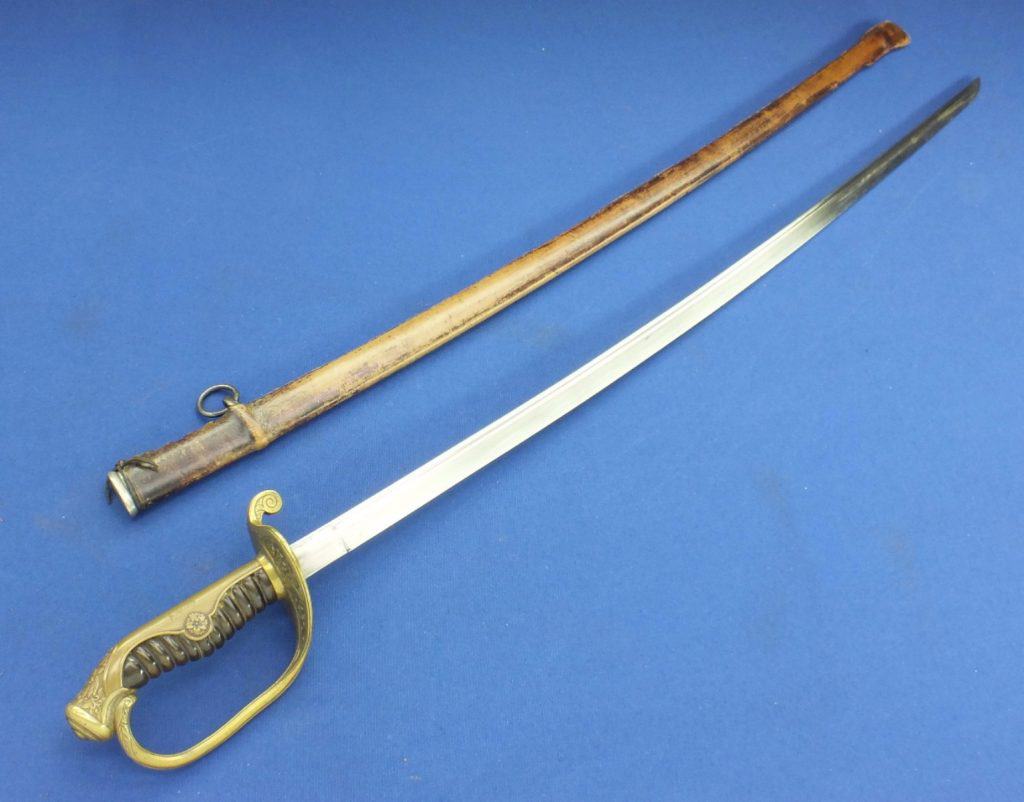
The first sword used by the Japanese military was called kyu gunto. This sword type came up in the 19th century and in contrast to the traditionally made katana the kyu gunto was a mass-produced sword.
The kyu gunto roughly resembles a western-style saber and has a very long grip and balance much like that of a katana. For the officers who were already familiar with all other Japanese swords, the kyu gunto was very easy to use.
This sword type was used until 1934. Thereafter it was replaced by the shin gunto also called new military sword.
Shin Gunto (new military sword)
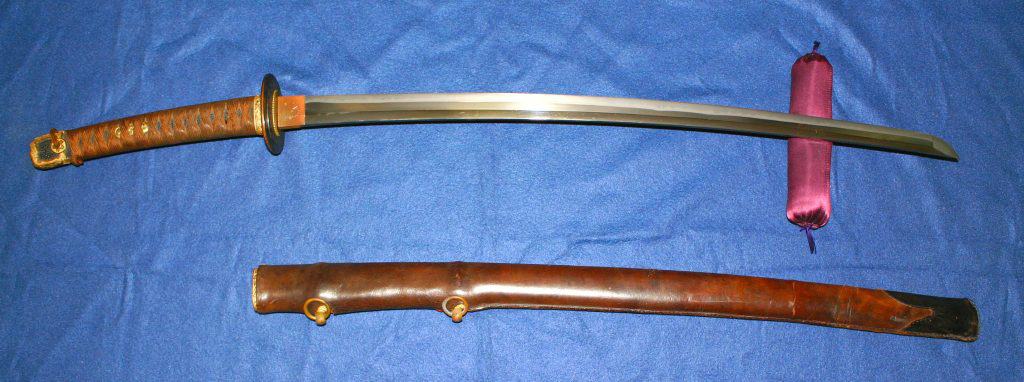
The shin gunto was used from 1935 until 1945. In contrast to the kyu gunto this sword is a bit smaller. This type of Japanese sword was originated as a part of the officers’ uniform of the Imperial Japanese Army.
Conclusion
This article kinda got very long. I hope that you are still with me :D
I really hope that I could give you detailed information on all the Japnese swords you could think of. Compiling this article was quite difficult as I researched a few of these sword types very extensively to provide you with the best information possible.
However, I am very sorry to admit that I couldn’t find the translation of every Japanese weapon name. Please forgive me, but I don’t know Japanese, thus I couldn’t translate the words myself.
For this reason I had to rely on everything I found online and in books. But even with that I missed the translation of 1 or 2 weapon kinds.
Nonetheless, this should be everything you need to know about the types of Japanese swords. In case you think I missed something please write it in the comments.
See you next time!